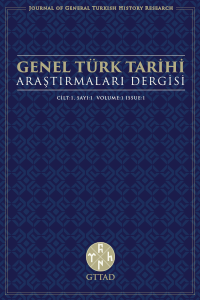BULGAR KENTLERİ VE BULGAR KENTLERİNİN KÖKEN SORUNLARI
Makalede İtil Bulgarlarının yerleşikleşme süreciyle bağlantılı olarak ilk sabit yerleşimlerin oluşumu, yerleşimlerin kent olarak değerlendirilme ölçütleri, kentlerin ortaya çıkışları ve kökenleri, kentlerin karakteristik özellikleri ve sınıflandırılma ile alakalı sorunlar incelenmiştir. Bu bağlamda Bulgar kentlerinin kökeninin, Bulgarların yerleşikleşme sorunu ve ilk sabit yerleşimlerinin ortaya çıktığı zaman ile bağlantılı olduğu tespit edilmiştir. Genel olarak araştırmacılar, çok farklı formda sosyal yapıya sahip olan kentlerin kökeni ve ortaya çıkış süreçlerine dair çok çeşitli seçeneklere meyil etmiştir. Yazar bu hususta Bulgar kentlerinin ortaya çıkışı ve kökeniyle alakalı varsayımda bulunan araştırmacıların görüşlerini irdeleyerek, köken sorunsalının aydınlatılması adına kendi varsayımlarını dayanaklı olarak belirtmiştir. Yazara göre boylar sisteminin geç aşamasında yani büyük boylar ve boylar arası birlikteliklerin oluştuğu anda vücuda gelen ve etno-sosyal oluşumların merkezi olan erken kentler zamanla idari, dini veya kültsel, askeri-politik merkezler ve ticaret noktaları olarak gelişmiştir. Müstahkem yerleşimlerin bahsi geçen gelişme noktaları, kentlerin köken sınıflandırmasını yani ortaya çıkış yollarının tespitini de beraberinde getirmiştir. Ortaçağ kentlerinin ortaya çıkış yollarının çeşitliliği İtil Bulgar kentleri üzerinde tatbik edilmiş, bu yollar Moğol öncesi İtil Bulgar materyalleriyle tasdik edilmiştir. Fakat araştırmacılar İtil Bulgar kentlerinin ortaya çıkış kökenleriyle ilgili belli başlı üç yol üzerinde durmuştur: boy merkezi, ticaret-zanaat merkezi ve idari-askeri kale.
BULGARIAN CITIES AND THE ORIGINAL PROBLEMS OF BULGARIAN CITIES
In the article, the formation of the first fixed settlements in connection with the settlement process of the Volga Bulgars, the criteria for evaluating the settlements as cities, the emergence and origins of the cities, the characteristics of the cities and the problems related to their classification were examined. In this context, it has been determined that the origin of the Bulgarian cities is related to the settlement problem of the Bulgars and the time when the first fixed settlements appeared. In general, researchers have tended to a wide variety of options regarding the origin and emergence processes of cities with very different forms of social structure. In this regard, the author examined the opinions of the researchers who made assumptions about the emergence and origin of the Bulgarian cities and stated his own assumptions in order to clarify the origin problematic. According to the author, the proto-cities, which came into being at the late stage of the tribal system, that is, when the large tribes and inter-tribal associations were formed and were the centers of ethno-social formations, developed over time as administrative, religious or cult, military-political centers and trade points. The mentioned development points of the fortified settlements brought along the origin classification of the cities, that is, the determination of the ways of their emergence. The variety of ways in which medieval cities emerged has been practiced on Volga Bulgar cities, these ways are attested by pre-Mongol Volga Bulgar materials (10th-13th centuries). However, researchers focused on three main ways of the origins of the Volga Bulgar cities: tribal center, trade-craft center and administrative-military fortress.
___
- ADAMOVİC, M, “Bulgaren an der Wolga?”, Materialia Turcica, Gettingen, 1998, s. 153-174.
- BEGOVATOV, E.A, “Denariy Ottona s İzmerskogo selişa”, Bolgar i problemı istoriçeskogo razvitiya Zapadnogo Zakam’ya. 60 let arheologiçeskogo izuçeniya. Tez. Nauç. Konf., Kazan, 1998, s. 40-41.
- BELAVİN, A.M, Kamskiy torgovıy put’: Srednevekovoe Prieural’ye v ego ekonomiçeskih i etnokul’turnıh svyazah, Perm’, 2000.
- DUBOV, İ.V, Velikiy Voljskiy put’, Leningrad, 1989.
